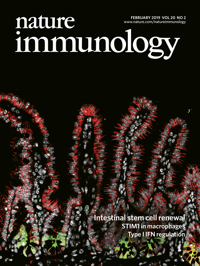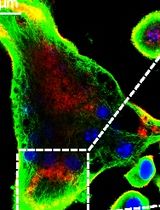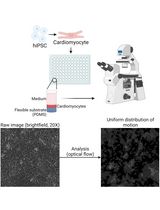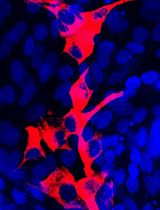- EN - English
- CN - 中文
In vitro Differentiation of Thymic Treg Cell Progenitors to Mature Thymic Treg Cells
体外胸腺调节性T细胞祖细胞向成熟胸腺调节性T细胞的分化
发布: 2019年08月20日第9卷第16期 DOI: 10.21769/BioProtoc.3335 浏览次数: 4622
评审: Alka MehraChris TibbittAnonymous reviewer(s)
Abstract
Thymic Treg cell differentiation occurs via a two-step process. Step one generates Treg cell progenitors (TregP) and is driven by strong TCR interactions with antigens presented in the thymus. Step two is initiated by activation of STAT5 via IL-2, or IL-15, leading to mature Treg cells capable of emigrating from the thymus and mediating immune tolerance and homeostasis in peripheral tissues. Herein we describe an in vitro TregP cell differentiation assay that models the second, cytokine dependent, step of thymic Treg cell development. It can be utilized with relative ease to determine if a population of thymocytes represents a potential progenitor population for Treg cells as well as test how different cytokines or chemical inhibitors modulate the differentiation of known TregP cell populations into mature Treg cells.
Keywords: Thymus (胸腺)Background
Regulatory T cells (Treg) cells are a population of T cells that can suppress immune responses and are required to maintain immune tolerance and tissue homeostasis. While two broad classes of Treg cells have been described, thymic Treg cells (tTreg) and peripheral Treg cells (pTreg), the majority of Treg cells are generated during thymic selection (Asano et al., 1996). Early experiments describing autoimmune manifestations in thymectomized mice, which can be rescued by Treg cell transfer, confirm the importance of the thymus in generating Treg cells capable of maintaining immune homeostasis (Asano et al., 1996). The development of Treg cells in the thymus is a two-step process (Burchill et al., 2008; Lio and Hsieh, 2008). The first step is TCR mediated and gives rise to CD25+Foxp3- or CD25-Foxp3lo TregP cells. The second step is mediated by contact of these progenitor populations with intrathymic cytokines leading to co-expression of CD25 and Foxp3 and generation of mature tTreg cells.
The in vitro TregP conversion assay models the second, cytokine dependent, step in tTreg cell development. This assay builds on protocols initially described by work from Chyi Hsieh’s lab and modified by our own lab (Burchill et al., 2008; Lio and Hsieh, 2008). The technique described below provides a simple method to determine if an isolated thymic population represents a TregP, characterized by independence from TCR stimulation and upregulation of tTreg markers in response to cytokine. This assay has been performed with varied stimulation conditions previously, including stimulation with high concentrations of IL-2 (200 U/ml) (Tai et al., 2013) as well as IL-2 + IL-7 (Lio and Hsieh, 2008). The protocol we describe converts bona-fide TregP to mature Treg cells robustly and reproducibly with small amounts of IL-2 (Mahmud et al., 2014; Owen et al., 2019). As such, investigators can narrow the application of IL-2 to concentrations that are more physiologically relevant. This assay has also been able to detect conversion of TregP to mature Treg cells with other cytokines like IL-7, IL-15 and IL-4, as well as combination of factors such as IL-2 with TNFRSF agonists (Mahmud et al., 2014). Thus, the in vitro TregP conversion assay can be used to query various important stimulatory, or inhibitory, signals that may be encountered in vivo by developing TregP.
Materials and Reagents
- Pipette tips
- 0.22 μm 1,000 ml Stericup (Millipore Sigma, catalog number: SCGPU11RE)
- 0.22 μm 50 ml Steriflip (Millipore Sigma, catalog number: SCGP00525)
- LS Columns (Miltenyi Biotec, catalog number: 130-042-101)
- 50 ml Falcon conical tube (Corning, catalog number: 352070)
- 15 ml CentriStar conical tube (Corning, catalog number: 430790)
- 5 ml Falcon Round Bottom test tube (Corning, catalog number: 352052)
- 96-well round bottom, non-TC treated plates (Sarstedt, catalog number: 82.1582.001)
- CytoOne Non-treated 6-well plates (USA Scientific, catalog number: CC7672-7506)
- Falcon 70 μm cell stainer (Corning, catalog number: 352350)
- Plain and frosted glass slides (VWR International, catalog number: 48312-004)
- Foxp3GFP (B6.Cg-Foxp3tm2(EGFP)Tch/J) mice (THE JACKSON LABORATORY, catalog number: 006772)
The best TregP cell yields come from younger (5-6 weeks old) female mice due to a generally large thymus. If younger mice are not available older mice will provide usable TregP cells. However, the number of TregP cells recovered could be reduced by 50% of that obtained from younger mice. - Recombinant Human IL-2 (R&D Systems, catalog number: 202-IL)
- Anti-mouse CD4 (GK1.5) BV786 (1:200) (BD Biosciences, catalog number: 563331)
- Anti-mouse CD8a (53-6.7) Biotin (1:200) (Tonbo Biosciences, catalog number: 30-0081-U500)
- Anti-mouse CD25 (PC61.5) PerCP-Cy5.5 (1:200) (Tonbo Biosciences, catalog number: 65-0251-U100)
- Anti-mouse CD73 (eBioTY/11.8) eF450 (1:100) (eBioscience, catalog number: 48-0731-82)
- Anti-mouse Ter119 (Ter-119) Biotin (1:200) (BD Biosciences, catalog number: 553672)
- (Optional) antibodies:
- Anti-CD11b (M1/70) Biotin (1:200) (Tonbo Biosciences, catalog number: 30-0112-U500)
- Anti-CD11c (N418) Biotin (1:200) (Tonbo Biosciences, catalog number: 30-0114-U500)
- Anti-NK1.1 (PK136) Biotin (1:200) (Tonbo Biosciences, catalog number: 30-5941-U500)
- Anti-γδTCR (eBioGL3) Biotin (1:200) (eBioscience, catalog number: 13-5711-85)
- Anti-B220 (RA3-6B2) Biotin (1:200) (Tonbo Biosciences, catalog number: 30-0452-U500)
- Streptavidin APC-eF780 (1:200) (eBioscience, catalog number: 47-4317-82)
- Viability Dye GhostTM Red 780 (1:1,000) (Tonbo Biosciences, catalog number: 13-0865-T100)
- Streptavidin Microbeads (Miltenyi Biotec, catalog number: 130-048-101)
- AccuCheck Counting Beads (Life Technologies, catalog number: PCB100)
- Sodium azide (NaN3) (Ricca Chemical, catalog number: 7144.8-16)
- 10x PBS (Fisher BioReagents, catalog number: BP399-20)
- Ethylenediaminetetraacetic Acid (EDTA) (Fisher Scientific, catalog number: BP120-500)
- Fetal bovine serum (FBS) (Atlanta Biologicals, catalog number: S11150)
- RPMI 1640 media (Corning, catalog number: 15-040-CV)
- Penicillin-Streptomycin Solution (Corning, catalog number: 30-002-CL)
- L-Glutamine (Corning, catalog number: 25-005-CL)
- MEM Nonessential amino acids (Corning, catalog number: 25-025-CL)
- 2-mercaptoethanol (MP Bio, catalog number: 02194705-CF)
- HEPES (Corning, catalog number: 25-060-CL)
- Sodium Pyruvate (Corning, catalog number: 25-000-CL)
- Sort Buffer (see Recipes)
- FACS Buffer (see Recipes)
- cRPMI (see Recipes)
Equipment
- Pipettes
- Sorvall Legend X1R Centrifuge (Thermo Scientific, catalog number: 75004260)
- BD Biosciences LSR II (BD, model: LSR II)
- BD Biosciences FACSAria II (BD, model: FACSAria II)
- MACS Multistand (Miltenyi Biotec, catalog number: 130-042-303)
- QuadroMACS Separator Magnet (Miltenyi, catalog number: 130-090-976)
- Class II Biosafety Cabinet/Laminar Flow Hood
- IncuSafe Incubator (Panasonic, catalog number: KM-CC17T0A)
- Hemocytometer (Fisher, catalog number: 0267110)
- Refrigerator (2-8 °C, Kenmore)
- Panasonic -80 °C VIP Plus Freezer
Software
- FlowJo 10 (10.5.3) (https://www.flowjo.com/)
Procedure
文章信息
版权信息
© 2019 The Authors; exclusive licensee Bio-protocol LLC.
如何引用
Owen, D. L. and Farrar, M. A. (2019). In vitro Differentiation of Thymic Treg Cell Progenitors to Mature Thymic Treg Cells. Bio-protocol 9(16): e3335. DOI: 10.21769/BioProtoc.3335.
分类
免疫学 > 免疫细胞分化 > T 细胞
细胞生物学 > 细胞分离和培养 > 细胞分化
您对这篇实验方法有问题吗?
在此处发布您的问题,我们将邀请本文作者来回答。同时,我们会将您的问题发布到Bio-protocol Exchange,以便寻求社区成员的帮助。
Share
Bluesky
X
Copy link













